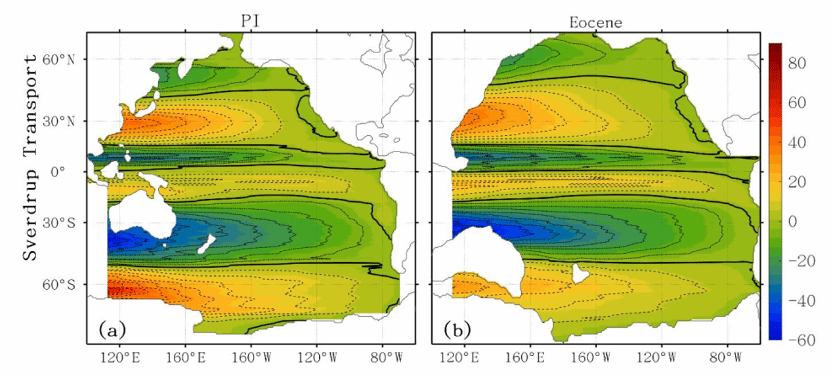Abstract
The large-scale oceanic gyre circulation in the Pacific regulates its temperature, salinity and nutrient flow, profoundly influencing the biological environment and climate. However, how gyres evolved during the warm Eocene, with its different coastline configurations, remains unknown. Here, we investigate the response of Pacific gyre circulation during the warm early Eocene using eight models from the Deep-Time Model Intercomparison Project (DeepMIP). Our DeepMIP results suggest a northward expansion of the North Pacific subtropical gyre by up to 10 degrees latitude during the Eocene, while maintaining a strength comparable to that of the present day. This simulated poleward expansion of the North Pacific gyre circulation is corroborated by sedimentary evidence, including poleward shifts in the pattern of clay sediments and low sedimentation rate during the Eocene. In the southern Pacific, the super subtropical gyre was much stronger during the Eocene than at present, due to the southward position of Australia, which created a wide-open Indonesian gateway. The poleward shift in the boundary between the subtropical and subpolar gyre in in the North Pacific is attributed to the northward migration of the westerly winds maxima, as confirmed by an analysis of Sverdrup transport. The Sverdrup-balanced upper circulation in the Pacific extends further poleward than in the modern day, mainly due to differences in the position of the continents. Specifically, the circulation corresponds to Sverdrup transport up to ∼53°N in the North Pacific, slightly further north than modern of limit of 50°N, and up to ∼55°S in the South Pacific, further south than in the modern limit of ∼45°S.

 Zhang, Y., de Boer, A. M., Guojin, Q., et al. Poleward expansion of North Pacific gyre circulation during the warm early Eocene inferred from inter-model comparisons. Palaeogeography, Palaeoclimatology, Palaeoecology, 2024. 112712
Zhang, Y., de Boer, A. M., Guojin, Q., et al. Poleward expansion of North Pacific gyre circulation during the warm early Eocene inferred from inter-model comparisons. Palaeogeography, Palaeoclimatology, Palaeoecology, 2024. 112712
https://doi.org/10.1016/j.palaeo.2024.112712